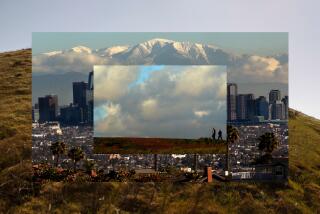Paths Into the Past in Blair Valley
Tucked between the high desert and low desert, between Whale Peak and Granite Mountain, is Blair Valley, an inviting locale for camping and hiking. Bouldered hills fringing the valley hide secluded campsites, and dirt roads and footpaths lead to cultural sites that offer a glimpse into the lives of the native Kumeyaay and the settlers who followed.
Getting to and around Blair Valley via County Highway S-2 and two-wheel-drive-passable dirt roads is fairly easy these days. Not so in the stagecoach era when the Butterfield Overland Mail wagons struggled across Blair Valley and over the high desert passes. At the northern edge of the valley was a rocky incline known as Foot and Walker Pass; it was so steep that stage passengers were often forced to disembark and walk--even help push the stage--over the pass. Atop the pass is a monument commemorating the pioneers who came this way and an excellent vista of Blair Valley.
Before settlers came this way, the native Kumeyaay camped in Blair Valley. They left behind morteros (grinding rocks) and pictographs (rock art), which today can be reached via short hikes.
In the 1930s Marshal South, his poet wife, Tanya, and their three children went native in a big way. They built an adobe house called Yaquitepec, collected rainwater in cisterns, cooked outdoors and lived a very back-to-nature life.
The ruins of Marshal South Cabin can be reached by trail. Ghost Mountain Trail (two miles round trip with 400-foot elevation gain) climbs steep, but well-graded switchbacks to the ruins of the cabin. Not much remains of the dwelling, except for some walls and foundations, but the panoramic view is well worth the climb.
To reach the trail head for the Marshal South Cabin, leave Highway S-2 at mile-marker 22.9 and turn east into Blair Valley. The dirt road passes many campsites as it travels 2.8 miles to a signed junction. Bear right to Ghost Mountain Trail and drive 0.4 mile to road’s end and the signed trail.
Return to the main road, then continue 1.2 miles to the signed morteros parking area. Mortero Trail (half a mile round trip) leads to dozens of grinding holes in the boulders, where Kumeyaay women pulverized seeds and pods, such as chia and mesquite beans.
To reach the beginning of Pictograph Trail, continue .1 mile beyond the morteros to a junction. The left fork leads north to Little Blair Valley, then north to S-2. (This narrow, sandy route is difficultfor two-wheel-drive vehicles. A safer bet back to the highway is the way you came.) Take the right fork and drive 1.5 miles to the parking area.
Pictograph Trail (2 1/2 miles round trip with 500-foot elevation gain) ascends a pinon pine- and juniper-dotted ridge, then descends and follows a sandy wash named Smuggler Canyon. About three-fourths mile from the trail head, look for the red- and yellow-hued pictographs on the face of a large boulder on the right side of the canyon.
From the pictographs, the path continues another half a mile through the canyon, which narrows, then abruptly ends at a 200-foot drop-off. From the lip of a dry waterfall, enjoy the good views.
(BEGIN TEXT OF INFOBOX / INFOGRAPHIC)
Ghost Mountain, Morteros, Pictograph Trails
WHERE: Blair Valley area, southern part of Anza-Borrego Desert State Park.
DISTANCE: 1/2 mile to 2 miles each round trip.
TERRAIN: Bouldered ridges of Blair Valley.
HIGHLIGHTS: Native rock art, an eccentric settler’s home site.
DEGREE OF DIFFICULTY: Easy to moderate.
PRECAUTIONS: Dirt roads not well signed.
FOR MORE INFORMATION: Anza-Borrego Desert State Park, 200 Palm Canyon Drive, Borrego Springs, CA 92004; tel. (619) 767-4205.
More to Read
Sign up for The Wild
We’ll help you find the best places to hike, bike and run, as well as the perfect silent spots for meditation and yoga.
You may occasionally receive promotional content from the Los Angeles Times.






